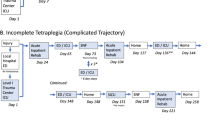Abstract
A previous investigation has indicated that spinal cord injury patients are more prone to develop reactions to intravenous contrast media. An investigation into the incidence of contrast reaction in 100 spinal cord injury patients undergoing intravenous pylography together with the incidence in a control group of 100 non-paraplegic patients, has been made. This has shown that spinal cord injury patients do not have a higher incidence of reaction. The aetiology of contrast reaction is briefly discussed with particular reference to the paraplegic patient.
Similar content being viewed by others
Log in or create a free account to read this content
Gain free access to this article, as well as selected content from this journal and more on nature.com
or
References
Ansell, G (1970). Adverse reactions to contrast agents. Invest. Radiol., 5, 374.
Ansell, G (1976). Complications in Diagnostic Radiology. Blackwell Scientific Publications, Oxford.
Coel, M N, Talner, L B & Lang, J H (1975). Mechanism of radioactive iodine uptake depression following intravenous urography. Br. J. Radiol., 45, 19.
Sandstrom, C (1955). Secondary reactions from contrast media and the allergy concept. Acta Radiol., 44, 233.
Simpson, K H, Cottrell, T L C & Lloyd, F A (1962). Intravenous pylography in the spinal cord injury patient. Amer.J. Surg., 103, 217.
Witten, D M, Hirsh, F D & Hartman, G W (1973). Acute reactions to Urographic contrast medium. Incidence, clinical characteristics and relationship to history of hypersensitivity states. Amer.J. Roentg., 119, 832.
Author information
Authors and Affiliations
Rights and permissions
About this article
Cite this article
Scher, A. Are spinal cord injury patients more prone to contrast reactions?. Spinal Cord 16, 366–369 (1979). https://doi.org/10.1038/sc.1978.69
Issue date:
DOI: https://doi.org/10.1038/sc.1978.69


